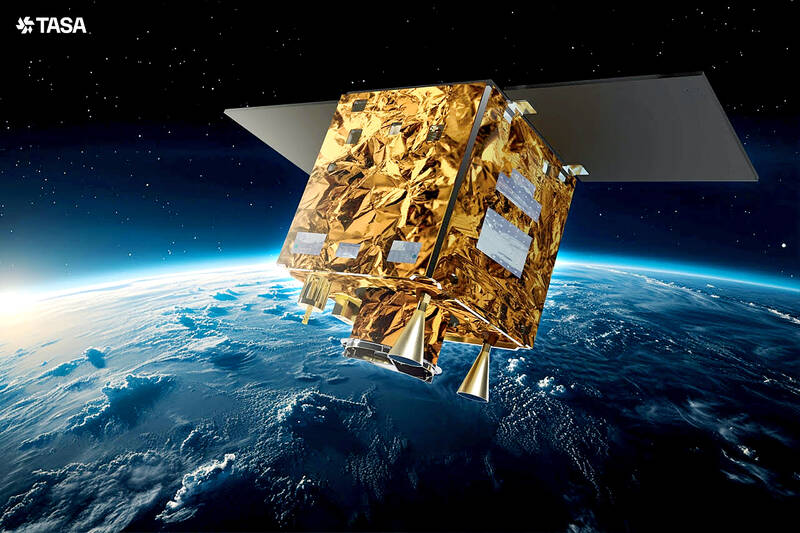Taiwan aims to send the nation’s first low Earth orbit (LEO) satellite into space in 2027, while the first Formosat-8 and Formosat-9 spacecraft are to be launched in October and 2028 respectively, the National Science and Technology Council said yesterday.
The council laid out its space development plan in a report reviewed by members of the legislature’s Education and Culture Committee.
Six LEO satellites would be produced in the initial phase, with the first one, the B5G-1A, scheduled to be launched in 2027, the council said in the report.

Photo courtesy of the Taiwan Space Agency
Regarding the second satellite, the B5G-1B, the government plans to work with private contractors to complete its communication payload system, with a verification test flight scheduled in 2030, it said.
The other four LEO satellites would be produced through partnerships with Taiwanese firms and overseas contractors, with the ultimate goal of cultivating two small satellite system developers in Taiwan, it said.
Meanwhile, the government would continue the development of remote sensing satellites, including Formosat-8 and Formosat-9, the council said.
The Formosat-8 system would include six high-resolution and two very high-resolution optical remote sensing satellites, with the first satellite scheduled to be launched in October, it said.
The Formosat-9 system would consist of two satellites with synthetic-aperture radar (SAR) capable of all-weather, day-and-night observations.
The system’s first satellite is scheduled to be launched in 2028, the council said.
The two remote sensing satellite systems would create a more comprehensive satellite observation network, it said.
Taiwan Space Agency Director-General Wu Jong-shinn (吳宗信) told the legislative committee that at least three of the Formosat-8 satellites would be equipped with edge computing capabilities.
Older satellite models collect and send raw data to ground stations for analyses, which often results in latency, consumes significant bandwidth and incurs high costs, the council said.
Satellites equipped with edge computing capabilities can filter and compress data in real time and conduct preliminary analyses, it said.
Only the results of analyses or signal errors would be transmitted to ground stations, greatly enhancing the efficiency of data transmission, it added.
The next generation of satellites would have artificial intelligence functions, enabling real-time object detection, environmental monitoring, and advanced level autonomous data processing and decisionmaking, the council said.
Formosat-8 is scheduled to be delivered to the US in August for launch following a final calibration, Wu said.
“We are aiming to gradually raise the domestic component ratio in satellites to 95 percent,” he said.
Democratic Progressive Party Legislator Chung Chia-ping (鍾佳濱) asked if SAR-equipped satellites can be used to support the military and the Coast Guard Administration in detecting Chinese rubber boats illegally entering Taiwan, given the difficulties in identifying such vessels with onshore radar systems.
Wu said that it is technically feasible if there are enough SAR-equipped satellites, adding that a broader range of observations can also be possible with the combination of SAR and uncrewed aerial vehicles that can stay in the air for more than 10 hours.
SAR can generate an image of nearly stationary objects, while inverse SAR can capture moving objects with precision, he said, adding that the agency would be glad to offer technical advice for such applications.

The Ministry of Foreign Affairs (MOFA) yesterday said it is closely monitoring developments in Venezuela, and would continue to cooperate with democratic allies and work together for regional and global security, stability, and prosperity. The remarks came after the US on Saturday launched a series of airstrikes in Venezuela and kidnapped Venezuelan President Nicolas Maduro, who was later flown to New York along with his wife. The pair face US charges related to drug trafficking and alleged cooperation with gangs designated as terrorist organizations. Maduro has denied the allegations. The ministry said that it is closely monitoring the political and economic situation

Conflict with Taiwan could leave China with “massive economic disruption, catastrophic military losses, significant social unrest, and devastating sanctions,” a US think tank said in a report released on Monday. The German Marshall Fund released a report titled If China Attacks Taiwan: The Consequences for China of “Minor Conflict” and “Major War” Scenarios. The report details the “massive” economic, military, social and international costs to China in the event of a minor conflict or major war with Taiwan, estimating that the Chinese People’s Liberation Army (PLA) could sustain losses of more than half of its active-duty ground forces, including 100,000 troops. Understanding Chinese

UNRELENTING: China attempted cyberattacks on Taiwan’s critical infrastructure 2.63 million times per day last year, up from 1.23 million in 2023, the NSB said China’s cyberarmy has long engaged in cyberattacks against Taiwan’s critical infrastructure, employing diverse and evolving tactics, the National Security Bureau (NSB) said yesterday, adding that cyberattacks on critical energy infrastructure last year increased 10-fold compared with the previous year. The NSB yesterday released a report titled Analysis on China’s Cyber Threats to Taiwan’s Critical Infrastructure in 2025, outlining the number of cyberattacks, major tactics and hacker groups. Taiwan’s national intelligence community identified a large number of cybersecurity incidents last year, the bureau said in a statement. China’s cyberarmy last year launched an average of 2.63 million intrusion attempts per day targeting Taiwan’s critical

‘SLICING METHOD’: In the event of a blockade, the China Coast Guard would intercept Taiwanese ships while its navy would seek to deter foreign intervention China’s military drills around Taiwan this week signaled potential strategies to cut the nation off from energy supplies and foreign military assistance, a US think tank report said. The Chinese People’s Liberation Army (PLA) conducted what it called “Justice Mission 2025” exercises from Monday to Tuesday in five maritime zones and airspace around Taiwan, calling them a warning to “Taiwanese independence” forces. In a report released on Wednesday, the Institute for the Study of War said the exercises effectively simulated blocking shipping routes to major port cities, including Kaohsiung, Keelung and Hualien. Taiwan would be highly vulnerable under such a blockade, because it